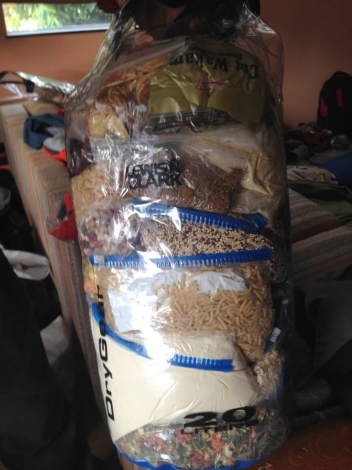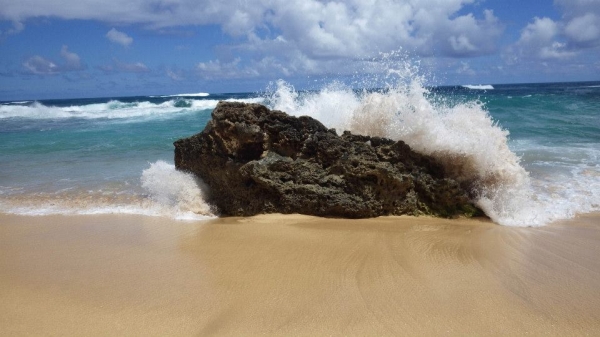Don't miss out on the best jobs!
Subscribe to HelpGoAbroad and weekly we will sent you an email with latest job posts. Provide your email address below
I’m headed with friends to the Kalalau Valley on Kauai’s Nā Pali Coast. My friend Isaac has boated in with most of our group’s gear. Jenny and I, carrying granola bars and sleeping bags and sarongs and books like “State of Wonder” by Ann Patchett and “Waking up in Eden” by Lucinda Fleeson and emergency supplies like Band-Aids and alcohol, hike the eleven miles of tropical trail that lead to the valley.
I’ll stay six days. Jenny and Isaac will stay for three weeks.
For the first few miles, Jenny and I say hello to day-hikers, young couples in Tevas, older mothers in floral slip-ons, and fathers in leather Jerusalem sandals. At the fifth mile, we eat round disks of pepperoni and string cheesex from plastic packages. At the seventh, where the trail narrows to a plank and the cliff steepens and pebbles plunge to the waves below, Jenny and I imagine we are characters on a reality show with cameras attached to our heads. The footage is shaky. Around the corner, we meet two girls in flip-flops with little gear. They have Nalgene bottles in their hands and Nylon backpacks with twine shoulder straps on their backs.
Jack London wrote about this portion of the Kalalau Trail in his short story “Koolau the Leper.” “A slip, and to right or left the man would fall to his death,” he wrote. “But once across he would find himself in an earthly paradise. A sea of vegetation laved the landscape, pouring its green billows from wall to wall, dripping from the cliff-lips in great vine-masses…”
“How’s it going?” Jenny asks the two girls.
“We’re getting Snickers,” the girl holding the blue water bottle says.
“Last night a few hikers gave us some Snickers. Now we need more,” her friend says.
“You’re hiking out for candy,” I say.
“Then we’re coming back,” the friend says.
I remember what a trusted hiker in Seattle told me, that some people live in the Kalalau Valley for weeks and months at a time, camping without permits and bartering homemade watercress pizza in exchange for batteries and chocolate bars. Some residents make their home in the valley, foresting for fruits and vegetables and sometimes planting their own gardens. Jenny and I make small talk, wish the young women well, and move on.
“Those must be valley girls,” I later say to Jenny.
As we approach our final miles, Jenny and I see a herd of goats on a bluff.
“I want them to run,” I say, “like a herd on the ‘Lion King.’”
We make the descent to the long empty beach in front of us. As we approach the campground where the sand meets the trees, a blonde-haired girl runs out to us from her campsite. She’s naked. She touches the nipple on Jenny’s hydration pack, and Jenny crouches so she can sip from the tube. Jenny asks how old she is. She says she’s three. When a tall man emerges from the campsite’s tent, stretches his arms, and emits a yawn as loud as a yell, the girl runs to his side.
Jenny and I wander through the campground looking for a good place to set down our backpacks and rest. At one campsite we meet a man with a long beard and intermittent teeth strumming a guitar with too few strings while a pot of water boils on a nearby grill. A few feet past him we find our friend Isaac in a camping chair, crouched forward, head in his hands. He says he has a headache from drinking too much rum after the boat dropped him off. Jenny asks where our supplies are at and where our camp is going to be.
“I was thinking deep valley,” Isaac says.
“I thought you said you’d have this figured out,” Jenny says.
“I was at the pirate party,” Isaac says.
“We were hiking.”
“But I’m home, baby. I’m home!” Isaac exclaims, rising from his chair with sudden energy. He walks to a tree behind him and climbs it.
“Can we get naked?” Jenny asks.
“You can do anything you want,” Isaac says, lobbing a papaya in her direction. “You’re free in the Kalalau.”
Isaac has visited the Kalalau Valley four times. Jenny and I have never visited.
Of course, the valley has not always been about pirate parties for young people seeking new levels of personal freedom in Edenic settings.
It has been about escape from civilization.
The Kalalau Valley has a bloody history. In the late 1800s, Hawaiians with leprosy avoided deportment and containment to Kalawao, a peninsula on the island of Molokai, by hiding in the Kalalau Valley illegally.
Jack London wrote “Koolau the Leper,” a piece of historical fiction about the real man who led the lepers with “cloven” feet and “bloated” ears to defend themselves from the soldiers who sought to quarantine them. Koolau, London writes, “was a hunted rat, a creature outside the law, sunk so deep in the mire of human horror that he was above the law as well as beneath it. His face was featureless, save for gaping orifices and for the lidless eyes that burned under hairless brows.”
After three soldiers died during the deportment of thirty lepers, the remaining lepers were left alone, including Koolau, his wife, and their son.
Koolau and his son died in the valley years later, and his wife Piilani eventually wrote about her experience, publishing “Ka Moolelo oiaio o Kaluaikoolau,” Hawaiian for “The True Story of Kaluaikoolau,” in 1906.
It wasn't until 1969 that the isolation policy was officially abandoned.
Jenny and I strip our clothes and jump in the ocean.
Later we haul our bags a mile across terraces where 19th and early 20th-century Hawaiians grew taro and yams. (Not only was this place at one time a hideout for Hawaiians with leprosy, it was home for larger groups of people before that. The history of the valley is as diverse as the vegetation that grows here.) Camping is not officially allowed on the terraces, but we come across tents every couple hundred feet and assume it’s okay. Jenny finds a bird’s nest on the ground and positions it in a tree trunk on the perimeter of a grassy clearing we will soon enough call “home.”
We hear the crinkling of leaves and look to the bushes upstream. A fat, silver-haired man climbs over a fallen tree and stands before us. He asks if we have a granola bar to exchange for guava. We tell him to check back in a week. His name is Metatron.
Isaac hangs my hammock in the trees. “Check for centipedes before you get in at night,” he says, “but don’t hurt them. They’re poisonous but spiritual.” I sit in the hammock and rock back and forth.
Photos taken by Derek Smith and Isaac Welch.
Sign in to publish a comment




Be the first to comment on this post.